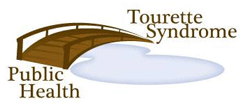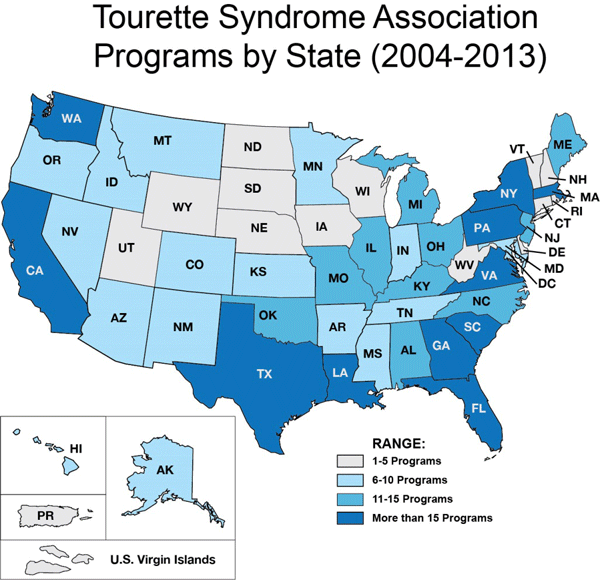10 Years of Tourette Syndrome Education and Research
 Tourette Syndrome Awareness month is May 15-June 15. Learn more about CDC’s decade of work doing research and educating the public on Tourette Syndrome.
Tourette Syndrome Awareness month is May 15-June 15. Learn more about CDC’s decade of work doing research and educating the public on Tourette Syndrome.
Tourette Syndrome (TS) is a neurological condition that causes people to have tics, which are sudden twitches, movements, or sounds that people do repeatedly. Having TS can have a serious impact on individuals and their families. In order to improve the lives of people with TS, CDC is bridging the gap between TS and Public Health by:
- Educating professionals and the public about TS
- Conducting research about TS and its impact on children’s lives
What we know about TS
Symptoms usually begin when a child is 5 to 10 years of age. Tic symptoms can vary from mild to severe, and can change over time. Often, tics decrease during adolescence and early adulthood, and sometimes disappear entirely. However, many people with TS experience tics into adulthood.
It is not known exactly how many people have TS, but it is likely that 1 or 2 of every 333 children have TS. Many people who have TS also have other mental, emotional and behavioral (MEB) conditions. The most common ones are attention-deficit/hyperactivity disorder (ADHD) and obsessive-compulsive disorder.

Why TS is a concern for public health
Living with TS can impact a person’s health, education, employment, family relationships and friendships, and has wide-ranging impact on their physical, mental, and emotional well-being. Children with TS often need many healthcare visits, special educational services, medication, and psychological and behavioral counseling. There are substantial costs for people living with TS.
Children with TS and their families may face many challenges. People are becoming more aware of TS, but there is still much misunderstanding and lack of knowledge, even among health and education professionals. This can lead to delays in diagnosis, so that many children do not have timely access to effective treatments. When TS is not understood by teachers, it can lead to significant problems in the classroom.
Because of its high impact, TS is a public health concern. CDC is conducting research to better understand TS and to inform outreach efforts to improve the health and wellbeing of people living with TS.
Educating the public for a decade
Since 2004, CDC has funded and supported the Tourette Association of America to provide much-needed educational programs. The Tourette Health and Education Program provides evidence-based information about TS to healthcare professionals, educators, families, and individuals with TS. As part of the outreach, the Tourette Association:
- Provides healthcare professionals, educators, and families with information on recognizing tics and diagnosing TS and other tic disorders.
- Provides healthcare professionals as well as families with up-to-date information about treatments for tics, including Comprehensive Behavioral Intervention for Tics or CBIT, a promising new treatment option.
- Dispels myths and stigma associated with TS.
- Educates professionals and families on TS and how it impacts children’s lives, and what they can do to help children learn.
- Supports families and individuals affected by TS so that they can manage their condition, be more understood by those around them, and have the opportunity to succeed in school and work.
The TSA-CDC Program has conducted over 650 programs for over 35,000 professionals and community members in every US state. Over 100,000 more professionals have received TSA-CDC educational materials through exhibits, mailings, and other outreach efforts.
The TSA-CDC partnership has been the primary source of information on CBIT since its emergence. In the past 3 years, they held 53 CBIT programs with over 1700 attendees.
Participants of the programs have reported learning new information on TS diagnosis and treatment, improving their skills, and changing their practice in working with people with TS.
- Approximately 95% of professionals reported that they gained knowledge that they will be able to use.
- Among healthcare professionals who attended a CBIT program, 90% reported that they plan to refer TS patients to receive CBIT and 81% reported that they plan to implement CBIT with their patients with tics.
- 93% of participants who attended community programs reported that they planned to use what they learned to address a specific concern about TS.

Figure 1: Map of United States showing Tourette Syndrome Association Programs by State (2004-2013). Ranges include:
- 1-5 Programs: Connecticut, Delaware, Iowa, Nebraska, New Hampshire, North Dakota, Rhode Island, South Dakota, U.S. Virgin Islands, Utah, Vermont, West Virginia, Wisconsin, Wyoming
- 6-10 Programs: Alaska, Arizona, Arkansas, Colorado, Hawaii, Idaho, Indiana, Kansas, Maryland, Minnesota, Mississippi, Montana, Nevada, New Mexico, Oregon, Puerto Rico, Tennessee, Washington D.C.
- 11-15 Programs: Alabama, Illinois, Kentucky, Maine, Michigan, Missouri, New Jersey, North Carolina, Ohio, Oklahoma
- More than 15 Programs: California, Florida, Georgia, Louisiana, Massachusetts, New York, Pennsylvania, South Carolina, Texas, Virginia, Washington
Conducting research
CDC conducts research to understand the factors associated with TS, and the public health impact of TS:
- Collaboration with the Health Resources and Services Administration to assess TS and other neurobehavioral conditions as part of ongoing national surveillance efforts.
- Findings from the 2007-08 National Survey of Children’s Health include:
- The first ever prevalence estimates of TS based on a nationally representative sample of US children: 1 out of 333 US children ever had TS.
- Parents of children with TS were more likely to report that their child had more health care needs and unmet needs, particularly if they had another mental, emotional and behavioral (MEB) condition.
- Parents of children with TS reported more parenting aggravation than parents of children without TS, particularly if they had another MEB condition.
- Findings from the 2007-08 National Survey of Children’s Health include:
- Collaboration with the University of Rochester and the University of South Florida to study the impact of tic disorders and co-occurring MEB conditions. They examined the impact of TS in different parts of a child’s life, including relationships with family and friends, how they do in school, which health services they use, as well as the costs of TS. In addition, investigators are working to identify which factors help children do well and which factors are connected to having problems, in order to inform future interventions. The analyses are ongoing; findings so far include:
- Children with chronic tic disorders including TS had more problems with social skills, which in turn were related to inattention, hyperactivity, and oppositional behavior.
- Diagnostic tools used for research do not identify children with TS well enough. This has led to the development of new tools for identifying TS in children that can be used in future research.
- Collaboration with the University of South Carolina and the University of Colorado Denver on a new, community-based study of children’s mental health that includes TS and tic disorders.
More Information
More Information
To find out more about TS, including education programs for families, healthcare and education professionals, and CBIT training, please visit the Tourette Health and Education Program.
- Page last reviewed: August 18, 2016
- Page last updated: August 18, 2016
- Content source:
- National Center on Birth Defects and Developmental Disabilities, Division of Human Development and Disability
- Page maintained by: Office of the Associate Director for Communication, Digital Media Branch, Division of Public Affairs




 ShareCompartir
ShareCompartir